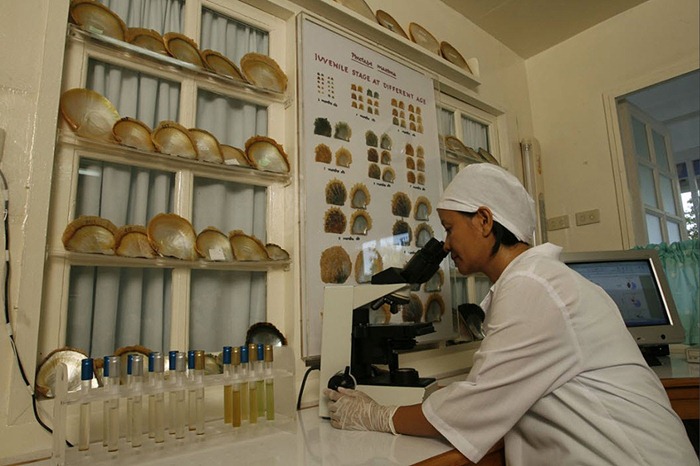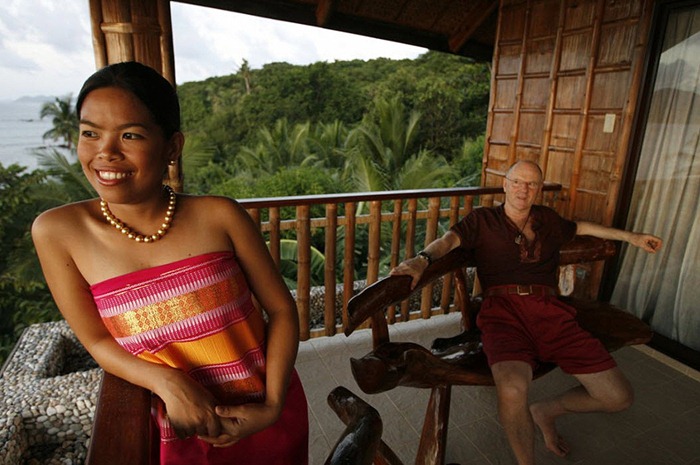The clean waters around the island of Palawan in the Philippines Sea have attracted investors to pearl farming for decades. There are several pearl firms actively operating at Palawan, but only one cultivates the exquisite and rare golden pearl – Jewelmer,

Jewelmer is the only pearl producer in the world that has successfully produced pearls with a rich, natural golden color. Through decades of research and biotechnology, Jewelmer was able to perfect the breeding process that produces gold-lipped Pinctada maxima pearl oysters capable of growing large, lustrous, golden pearls. This deep, rich color can only be found in South Sea pearls produced in the Philippines.
Pearls are cultured by transplanting a tiny piece of mantle tissue of an oyster shell into a the shell of a young oyster. This graft forms a pearl sac and precipitate calcium carbonate into this pocket. Over time, this grows into a pearl. It takes 2 to 5 years for a pearl to mature. "Cultivation of pearls is very time-consuming process," explains Jacques Branellec, managing director of Jewelmer. "Any change in temperature and water conditions can affect the oysters. For 38 years I have been in cultivation of pearls, but I’m always learning something new.”

Jacques Branellec showing pearls from a new harvest.

The archipelago of Palawan

A Pearl farm.

A board showing the placing and the state of the oyster lines on one of the Palawan farms.

A biologist examining a gold pearl under a microscope.

Three species of Oysters: (left to right) white, gold, black.

Young oysters are carefully cleaned of dirt and parasites before placing them into new cells.

Young oysters are transported by helicopter to a neighboring farm for further growth.

A worker holding a cage where oysters will spend the next 2 to 3 years.


Guards overseeing a farm ship.

Oyster cages are suspended by ropes at a depth of 15 meters.




Workers pull up cages of ripe pearls.



Oysters are thoroughly washed before they are opened.

Jacques Branellec oversees the process of harvesting pearls on one of his farms.
 .
.

Pearls are carefully removed from the oysters. Only a few experts have the ability to open these oysters without damaging the pearls.



The oysters shells, in turn, are cleaned and sold to restaurants in Manila.

During one week of harvest thousands of pearls are collected. Each sells for 500 Euros. But the pearls of the highest class can cost several times more.

In the workshops pearls sort out and evaluated.


Designer develop new jewelry of pearls.

Gold jewelry pearl.


Jacques Branellec on his farm, along with an assistant on the neck of which flaunts a necklace of golden pearls.

Jewelmer is the only pearl producer in the world that has successfully produced pearls with a rich, natural golden color. Through decades of research and biotechnology, Jewelmer was able to perfect the breeding process that produces gold-lipped Pinctada maxima pearl oysters capable of growing large, lustrous, golden pearls. This deep, rich color can only be found in South Sea pearls produced in the Philippines.
Pearls are cultured by transplanting a tiny piece of mantle tissue of an oyster shell into a the shell of a young oyster. This graft forms a pearl sac and precipitate calcium carbonate into this pocket. Over time, this grows into a pearl. It takes 2 to 5 years for a pearl to mature. "Cultivation of pearls is very time-consuming process," explains Jacques Branellec, managing director of Jewelmer. "Any change in temperature and water conditions can affect the oysters. For 38 years I have been in cultivation of pearls, but I’m always learning something new.”

Jacques Branellec showing pearls from a new harvest.

The archipelago of Palawan

A Pearl farm.

A board showing the placing and the state of the oyster lines on one of the Palawan farms.

A biologist examining a gold pearl under a microscope.

Three species of Oysters: (left to right) white, gold, black.

Young oysters are carefully cleaned of dirt and parasites before placing them into new cells.

Young oysters are transported by helicopter to a neighboring farm for further growth.

A worker holding a cage where oysters will spend the next 2 to 3 years.


Guards overseeing a farm ship.

Oyster cages are suspended by ropes at a depth of 15 meters.




Workers pull up cages of ripe pearls.



Oysters are thoroughly washed before they are opened.

Jacques Branellec oversees the process of harvesting pearls on one of his farms.
 .
.
Pearls are carefully removed from the oysters. Only a few experts have the ability to open these oysters without damaging the pearls.



The oysters shells, in turn, are cleaned and sold to restaurants in Manila.

During one week of harvest thousands of pearls are collected. Each sells for 500 Euros. But the pearls of the highest class can cost several times more.

In the workshops pearls sort out and evaluated.


Designer develop new jewelry of pearls.

Gold jewelry pearl.


Jacques Branellec on his farm, along with an assistant on the neck of which flaunts a necklace of golden pearls.
